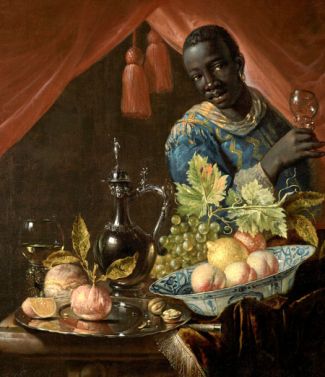Still Life with Male Figure
"Still Life with Male Figure" is the descriptive title of a 17th century Dutch oil painting held and exhibited at the Birmingham Museum of Art. The 35 7/8" tall by 31 5/8" wide canvas is signed by Juriaen van Streek (1632–1687), an Amsterdam innkeeper and well-regarded painter of still lifes. The painting depicts a young Black man dressed in rich blue and gold fabrics standing behind a table laden with fruits, nuts, and wine in glass, silver and porcelain vessels. The scene is framed by a the edges of a red fabric tent with hanging tassels.
The painting was auctioned by Kunsthaus Lempertz of Köln, Germany in 1926, where it was purchased by Paul Ludowigs, a manager for Rheinisch-Westfälische Kalkwerke which mined dolomite for use in steel manufacturing. The painting remained in his family until it was auctioned by Sotheby's in November 2005. Amsterdam art dealer Salomon Lilian entered the winning bid, and sold the painting to a London collector in 2012. Lilian re-acquired the painting in 2016. It was exhibited at the Frans Hals Museum in Haarlem in 2017 and at the 2018 Tefaf Maastricht art fair, but went unsold. Birmingham's Art Fund, Inc. acquired the work later that year with funds from long-time museum supporter Margaret Livingston.
The purchase of this painting was aligned with the museum's concentrated effort to "work more closely with and for the local community" by diversifying its public offerings, as well as its staff, leadership and patronage. Robert Schindler, then curator of European art, identified the Van Streek painting as one of the first moves by his department "to begin remedying the shortcomings of the collection," in portraying the stories of "people of color, non-Western perspectives and colonialism" in his section. The museum re-framed the panel with protective glass and placed it within the gallery dedicated to Dutch and Flemish art. Museum staff collaborated extensively on the wording of the gallery label, laboring on "how to appropriately account for the complex histories and experiences of Africans in the Netherlands," given that the work was then the sole representation of colonialism and/or the slave trade in the European galleries.
References
- Schindler, Robert and Lloyd DeWitt (December 2020) "Diversifying the Collection: New Acquisitions from the Birmingham Museum of Art and Chrysler Museum of Art." CODART.nl
External links
- "Still Life with Male Figure at artsbma.org
